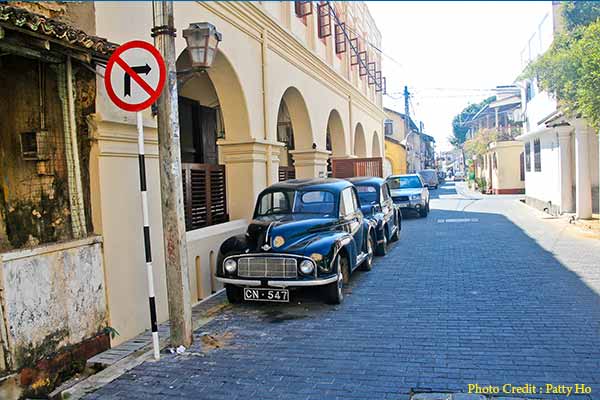Galle Dutch Fort
.Galle Fort is located southwest coast of Sri Lanka. It was built by the Portuguese, in 1588 and then extensively fortified by the Dutch during the 17th century from 1649 onwards. It is a historical, archaeological, and architectural heritage monument, which is more than 423 years old. Currently, reconstruction work is being done by the Archaeological Department of Sri Lanka.
The fort has a colorful history, and today has a multi-ethnic and multi-religious people living in this place. The Sri Lankan government and many Dutch people who still own some of the properties inside the fort are looking at making this one of the modern wonders of the world.
The heritage value of the fort has been recognized by UNESCO. This site has been inscribed as a cultural heritage UNESCO World Heritage Site under criteria iv, for its unique exposition of “an urban ensemble which illustrates the interaction of European architecture and South Asian traditions from the 16th to the 19th centuries.”
Galle Fort
Galle Fort is a Unesco listed World Heritage Site. This memorable city is a pleasure to investigate on walking. An unendingly outlandish old exchanging port favored with forcing Dutch-provincial structures, old mosques and places of worship, terrific chateaus, and galleries. Meandering its drifting paths you’ll pass snappy bistros, particular boutiques, and faultlessly reestablished inns claimed by nearby and outside specialists, essayists, picture-takers, and creators. Galle Fort has an ancient history and there are a lot of things to do in Galle.
Worked by the Dutch, starting in 1663. Galle’s center is the Fort, a walled enclave encompassed on three sides by the sea. A key piece of the Fort’s allure is that it isn’t only a pretty spot. Without a doubt, the travel industry currently overwhelms the neighborhood economy. However, this one-of-a-kind city remains a working network. There are regulatory workplaces and courts, trade organizations, schools, and colleges. There are many things to do in Galle. Most voyagers are completely tempted by Galle’s feel, and it’s without a doubt southern Sri Lanka’s unmissable sight.
The ocean-side town of Galle is 116 Km far from Colombo by street or rail, down the south shore of Sri Lanka. Both are scenic and picturesque. You can likewise take the Southern Expressway on the off chance that you have to achieve the city by a fraction of the time yet there isn’t much view to appreciate. The present town has developed significantly and spread into the environment yet the Fort is the slow-beating heart of Galle’s history. The walled city has remained since the mid-sixteenth century, through the Colonial times of the Portuguese. Dutch and British and in our present occasion is broadcasted as an Archaeological Reserve and has been recognized as a living World Heritage Site.
The historical underpinnings of the name Galle have been clarified as likely a modified type of the Sinhalese word “GALA”. A cow’s crease or posting place from which the Portuguese named it Point-de-Galle. The more straightforward and increasingly well-known hypothesis is found in the closeness of the Sinhalese word: GALA, which the Portuguese copied by receiving the Latin word: gallus, for rooster. They subsequently structured the crest of the city as that of a rooster remaining upon a rough roost.
The Portuguese took Galle from the Sinhalese in 1587 and raised the primary fortress. A solitary divider fronted by a canal that stretched out from the ocean to the harbor.
The Dutch landed in 1640, under the command of Wilhelm Jacobsz Coster who defeated the Portuguese. The Dutch later changed over the Portuguese “fortalezza” into a solitary bastion which they named Zwart Bastion. They constructed a considerable line of resistance, ringing the walled town by ten bastions, which suffer right up ’til today. Akersloot Bastion is named after the origin of Coaster, the Dutch authority who caught Galle. The name has been etched on a stone at the spot and furthermore bears a date which, notwithstanding, doesn’t matter to the date of erection of the Bastion. The old dividers are a most loved promenade for Galle’s natives and its guests alike.
Through the moving surges of Time and Change, Galle still holds – as a couple of different towns in Sri Lanka – an ether of the past. The town was graced with significant public facilities and military highlights. Two hundred years back a storm-water outflow framework was presented that avoided flooding in the Fort. It was so complex as to have extraordinary block-lined, underground depletes, which were consequently flushed two times every day by the tide. In spite of ongoing face-lifts and new veneers to a considerable lot of the houses and the presentation of current municipal pleasantries like power, phone frameworks, water, and seepage benefits. The boulevards stay restricted and many are referred to by their unique names, for example, Leyn-Baan road, Zeeberg road, and Moderabaay road.
A peep into the old houses uncovers them to be extensive and breezy, with huge, decorative entryways and windows, pillared verandas, and cool internal patios and greenery enclosures. There are many things to do in Galle, Do you like to see the Galle Tours or contact us for more details..
Most useful links
Home Travel Tips Get free Quote
Share this tourOur Speciality
Contact Info
+94 77 4 260 250
ccd@hellowtravel.com
No. 427/2, Siyambalape North,
Siyambalape.Monday-Friday 8.00am to 5.00 pm
Saturday 8.00 am to 1.00 pm












